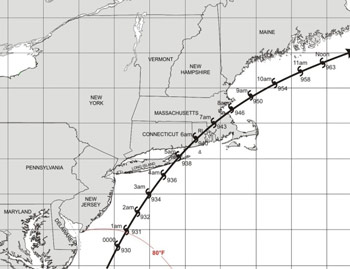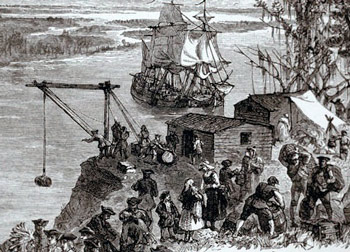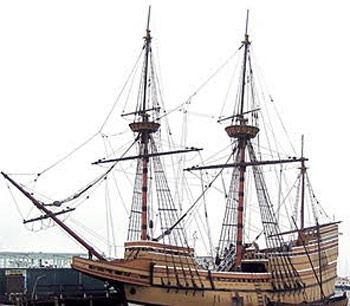The Great Colonial Hurricane of 1635
by Tom Seymour

Estimated path of the Hurricane of 1635. At about 10 am the eye of the storm would have passed below Pemaquid, Maine. National Hurricane Center map
No one in the colonies, neither colonists nor Indians, had experienced anything like it. What would later be dubbed “The Great Colonial Hurricane of 1635” was a bruiser. Scientists today estimate that winds hit 130 miles per hour and the accompanying storm surge contained a 21-foot-high crest. Figures indicate that this was the most powerful storm to make landfall north of Cape Fear, North Carolina and the storm surge was the highest along the east coast in recorded history.
The winds clipped mature, first-growth white pines in half and the storm surge drowned countless victims who had tarried too long near the coast.
Houses were torn asunder and ships were blown onto rocky shores, their anchors and chains insufficient to hold them against the howling wind. Crops, necessary to the survival of the colonists, were destroyed, as were large swathes of forest. Many thought that the end of time had come and given their lack of experience with such raging tempests, they couldn’t be blamed for such apocryphal thoughts. More than 46 deaths are attributed directly to the effects of the hurricane.
Recent findings using extensive data garnered from colonial journals by the National Hurricane Center now point to the hurricane tracking further west than was generally thought. This track took the storm directly over eastern Long Island and from there it moved on to New England. Current estimates put the hurricane at a strong Category 3, moving at speeds greater than 30 miles per hour.
Early Records

Drawing of the James, which sailed with the Angel Gabriel in background.
Colonial leaders kept extensive diaries and some of these recorded the great hurricane. First mention comes from Colonial Jamestown in Virginia, on August 24, 1635. But since the hurricane apparently passed far enough east of the town so that it caused no damage, it was given little notice except for brief mention. However, once the storm reached New England, conditions changed dramatically.
Governor William Bradford of Plymouth Colony wrote that the hurricane, “…blew downe sundry houses & uncovered others. Diverse vessels were lost at sea, and many more were in extreme danger. It caused ye sea to swell about 20 feete, right up & downe, and made many of the Indeans to clime into trees for their safetie.”
Governor Bradford continued, writing that, “Such a mighty storm of wind and rain as none living in these parts, either English or Indian, ever saw.”
John Winthrop, leader of the Massachusetts Bay group, recorded in his diary that the winds became stronger than normal one week ahead of the hurricane. Winthrop wrote that the hurricane, “…blew with such violence, with abundance of rain, that it blew down many hundreds of trees, overthrew some houses, and drove the ships from their anchors.
Winthrop also mentioned how eight Indians were drowned while, “flying from their wigwams.”
Shipwrecks
The great hurricane played havoc with ships at sea. Two vessels in particular, the James and the Angel Gabriel, were part of the Great Migration, where English Puritans sailed to the new world to enjoy religious freedom.
The James and Angel Gabriel, along with three other ships, sailed out in June of 1635. The three other ships were smaller and consequently, made better speed and landed in the new world unharmed. But James and Angel Gabriel, soon lagged behind and so shared much of the journey together. However, in early July the two vessels decided to split up. Both ships arrived on the other side as the hurricane was at its worst.
The Angel Gabriel was able to discharge the majority of its passengers safely and these took shelter with the residents of Pemaquid, Maine. Meanwhile, the ship anchored, safely those on board thought, in Pemaquid Harbor.
But that night the hurricane ripped the vessel from its moorings and dashed it to splinters. Those few passengers who remained on board were lost to the waves, while those who had gone ashore later found themselves picking through the wreckage for personal items.
The James, which was a bit further south, tried to find a protected area around the Isles of Shoals. However, the ships’ cables were too weak to bear the weight of the storm-tossed ship and all of the James’ anchors were lost.

Reproduction of the Mayflower at Plymouth, MA. The Angel Gabriel was of similar design and size.
To make matters worse, a 20-foot storm surge was having its way with the vessel, pushing it ever so begrudgingly, toward shoreline rocks. Crew and passengers were unable to do anything but watch and pray as their ship neared its inevitable fate. But then something totally unexpected occurred. The winds began to blow from the opposite direction, carrying the ship away from the rocky islands.
But the James’ ordeal was not over. It appeared as if the ship must be driven on the rocky shoreline of the mainland. But the crew made recourse to its one and only option and set out their storm sail. This allowed them to steer the ship into Hampton Harbor. After danger had passed the James made its feeble way into Boston, its sails hanging like so many rags.
Another vessel to fall victim to the great storm was the Watch and Wait, a small barque, which was dashed to bits on a rocky island known today as Thatcher’s Island.
Anthony Thatcher and his family determined to leave Ipswich, Massachusetts and settle in Marblehead Massachusetts. Thatcher and his family were accompanied by his cousin, Avery, and his family. The two families boarded the Watch and Wait and along with four sailors, set out to sea. The planned route was around Cape Ann and from there, into Marblehead. This was a routine journey, or would have been under normal conditions.
But in the waters off of Gloucester, the vessel got caught in the hurricane. The crew decided to drop anchor and weather the storm at sea. However, as with the James and the Angel Gabriel, anchors and cables were insufficient to hold the little barque against the raging winds of the Great Colonial Hurricane of 1635.
The violent storm was so powerful that the crew lost control of the ship and it finally came ashore on the rocks of a small island. The ship broke up, sweeping everyone out to sea. The only ones to survive were Thatcher and his wife. All the rest perished.
Thatcher reached shore first and in time, spotted something familiar in the wreckage. It was his wife and she struggled frantically to free herself from the wreckage. After doing so, she was able to climb up the beach.
The two sat out the storm on their rocky perch, waiting, looking, searching and hoping for their loved ones and crew. But no bodies appeared, no sign of the lost was ever found. In less than two days, however, a passing ship spotted the two on their desolate landing and rescued them. The little rocky speck of land became known as “Thatcher’s Island” and today, the island bearing Thatcher’s name is home to twin lighthouses.
The General Court of Massachusetts later granted the island to Thatcher. Thatcher himself finally settled in Yarmouth, Massachusetts and is buried there. A stone monument near the gravesite marks his final resting place.
Contemporary sources indicate that damage from the 1635 hurricane was still in evidence in 1685, fifty years later.
